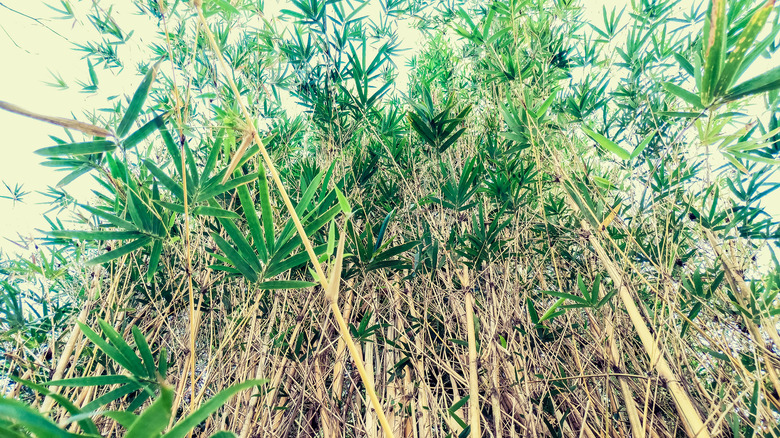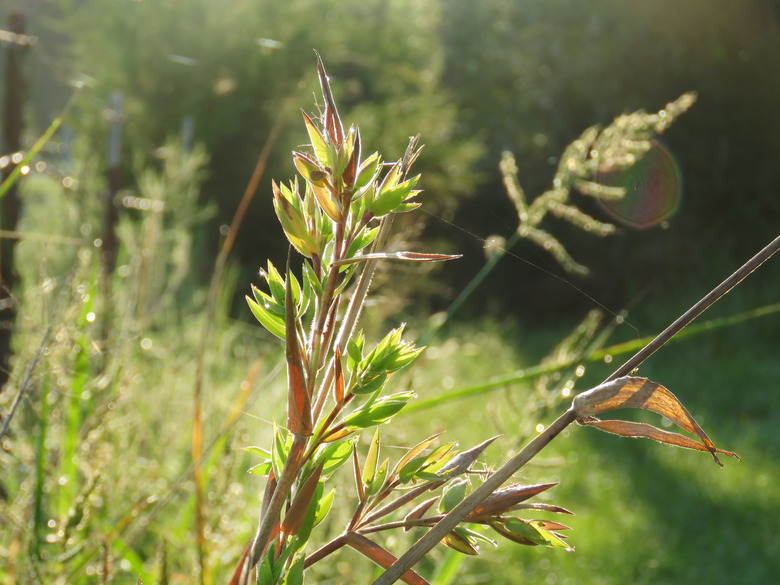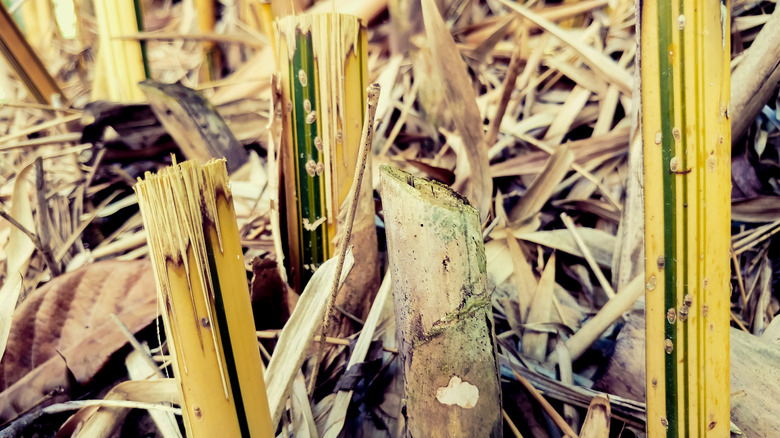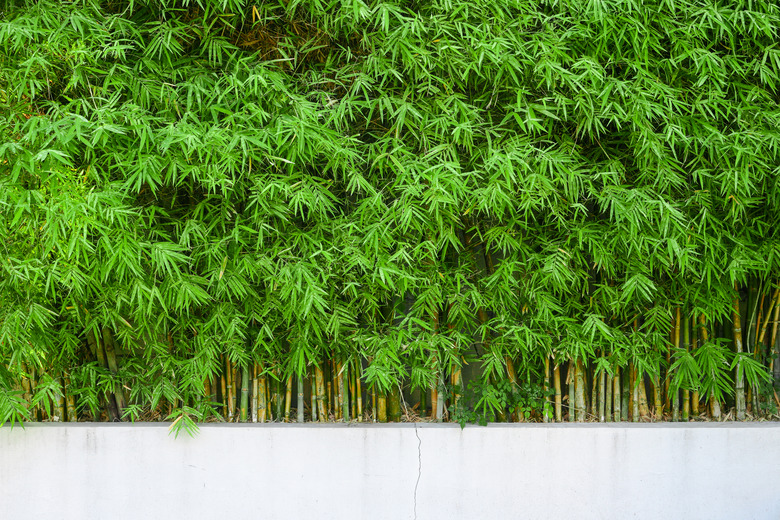Growing Bamboo In North Carolina
The warm summers and mild winters found throughout much of North Carolina provide an ideal environment for growing bamboo. The state falls within USDA hardiness zones 6 to 8, which is a climate suited to a range of bamboo species. In particular, the eastern half of the state is hospitable to most bamboo varieties.
Bamboo's rapid growth rate and low maintenance care requirements make it an attractive landscaping plant to many gardeners. However, some varieties are highly invasive throughout North Carolina, so exercise caution when choosing and planting these vigorous growers at home.
Warning
One variety of bamboo that should never be planted in North Carolina is fishpole or golden bamboo (Phyllostachys aurea, zones 4a to 10b), which is listed as an invasive species by the North Carolina Invasive Plant Council.
Choosing the Right Bamboo
Choosing the right type of bamboo is the first step toward growing it in your home garden. For instance, **most bamboo varieties are evergreen, but there are also some that are deciduous or semi-deciduous.**
**Clumping bamboo varieties are best for landscaping purposes in North Carolina,** because they do not spread as vigorously as running bamboo types that spread via underground rhizomes.
Chinese Dwarf Bamboo
Alphonse Karr bamboo (Bambusa multiplex 'Alphonse Karr', zones 8 to 10) is an ornamental cultivar of Chinese dwarf bamboo grown for its green and yellow striped culms, or stalks. This cultivar forms dense clumps that can reach 35 feet in height but it can also be pruned to a height of 8 to 10 feet, according to Monrovia.
Golden Goddess (Bambusa multiplex 'Golden Goddess') is an attractive dwarf cultivar grown for its golden yellow foliage and tidy growth habit. It grows best in USDA zones 8 to 10, where it will form a dense clump that is 6 to 10 feet high with a 6- to 10-foot width.
Green Panda Bamboo
Another suitable choice for North Carolina is Green Panda hardy bamboo (Fargesia rufa 'Green Panda'). It grows best in USDA zones 5a to 8b, where it resists cold, heat and drought damage. Green Panda bamboo reaches a mature height of 6 to 10 feet and spreads its graceful, arching canes 6 to 10 feet wide.
Native Bamboo Species
Small cane bamboo (Arundinaria tecta, zones 6a to 9b) and river cane (Arundinaria gigantea, zones 5a to 9b) are two native plant bamboo options for gardens in North Carolina. They are not as showy as non-native bamboo varieties, but they provide cover and a valuable food source to native birds and butterflies.
One downside to small cane and river cane bamboo is that **both species are extremely flammable.**
Tip
Whenever possible, buy plants from a bamboo nursery where the nursery staff can provide good recommendations and accurately labeled bamboo varieties.
Growing Bamboo in North Carolina
Once you have chosen a non-invasive bamboo variety, it is time to choose and prepare a growing location.
Environmental Requirements
**Sun Exposure:** As a general rule, bright light will produce more vivid foliage color, so most bamboo should be grown in full sun. However, varieties such as Green Panda need light midday shade, because they are sensitive to high heat.
**Soil Type:** Bamboo is very tolerant of different soil types, as long as the soil is moist and fast draining. It grows best in soil with a slightly acidic to neutral pH, which is a good thing since most of North Carolina has somewhat acidic soil.
**Wind Shelter:** Clumping bamboo benefits from having a wind-sheltered location to keep the culms from bending. A line of trees or a structure 20 to 30 feet away from your bamboo planting will help cut down on wind exposure without blocking out the sun.
Planting Bamboo
Planting a bamboo clump can be done at any time of year, as long as the soil is somewhat warm. Spring is best for cooler climates, and autumn works in climates with mild, wet winters.
- Dig a planting hole that is twice the width of the bamboo's original pot and the same depth.
- Settle the bamboo in the planting hole. Make sure the base of the stems are level with the surrounding soil.
- Backfill around the roots until the rootball is completely covered. Gently tamp the soil.
- Spread a 2-inch layer of mulch over the root zone, leaving a few inches between the bamboo and the mulch layer. Mulch will help eliminate competition from weeds and nearby plants such as groundcover.
Caring for Bamboo
Bamboo generally needs very little hands-on care. Provide 1 to 2 inches of water each week for the first summer. Don't worry about watering established bamboo plants unless prolonged drought conditions develop. Mulch will help reduce the need for watering.
Occasional feeding with liquid, general purpose fertilizer will help encourage strong growth in bamboo plants, but it is not required in average soil. A side-dressing of compost in spring also works and is an organic option.
Bamboo shoots that form near the base of the plant should be trimmed away throughout the year to maintain a tidy perimeter around the clump. Snip off the shoot at soil-level using sturdy pruners or a pruning saw.
Controlling Bamboo in Your Garden
Clumping bamboos spread less aggressively than running bamboo varieties, however, it is still a good idea to create any bamboo landscape planting with a barrier to keep the plants in check.
A concrete patio or walkway around the bed is ideal, but a plastic root barrier installed around the outer edge of the bed will also work. Use a root barrier that descends 24 to 36 inches deep.
Sometimes bamboo plants come with inaccurate labeling, so you might not know for sure if the bamboo variety you're about to plant is clumping or spreading—when in doubt, keep your bamboo in a pot!
References
- North Carolina Cooperative Extension: Clumping Bamboos
- North Carolina State Extension: Phyllostachys Aurea
- North Carolina Cooperative Extension: Bambusa Multiplex
- Monrovia: Alphonse Karr Bamboo
- Monrovia: Golden Goddess Bamboo
- North Carolina Cooperative Extension: Green Panda Bamboo
- North Carolina Cooperative Extension: Small Cane
- North Carolina Cooperative Extension: River Cane




